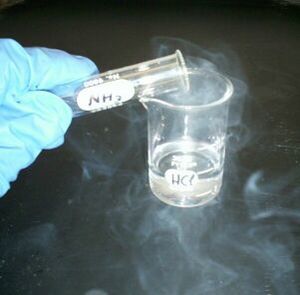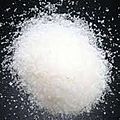Base (chemistry) facts for kids
A base is a substance that can accept a hydrogen ion (H+) from another substance. A chemical can accept a proton, which has a positive charge, if it has a negative charge or if the molecule has an electronegative atom like oxygen, nitrogen, or chlorine that has many extra electrons. Like acids, some bases are strong and others are weak. The weak bases are less likely to accept protons, while the strong bases quickly take protons in solution or from other molecules. An acid is a base's "chemical opposite." An acid is a substance that will donate a hydrogen atom to the base.
Bases have a pH greater than 7.0. Weak bases generally have a pH value of 7–9 while strong bases have a pH value of 9–14.
Contents
How bases work
Bases can be used to neutralize acids. When a base, often OH–, accepts a proton from an acid, it forms a harmless water molecule. When all of the acids and bases react to form water molecules and other neutral salts, it is called neutralization. Acids can also be used to neutralize bases.
Every base has a conjugate acid formed by adding a hydrogen atom to the base. For example, NH3 (ammonia) is a base, and its conjugate (containing two or more radicals supposed to act the part of a single one) acid is the ammonium ion, NH4+. A weak base forms a strong conjugate acid and a strong base forms a weaker conjugate acid. Since ammonia is a moderately strong base, ammonium is a much weaker acid.
Characteristics
Bases have these characteristics:
- Bitter taste (opposed to the sour taste of acids)
- Slimy, or soapy feel on fingers (Slippery)
- React with acids and make a salt solution
- Turn red litmus paper blue
- Contain metal oxides or hydroxides
- Soluble in water form alkalis (soluble bases)
- Strong bases may react violently with acids. An acid spill can be safely neutralized by using a mild base.
Some common household products are bases. For example, lye and drain cleaners are made from sodium hydroxide, a strong base. Ammonia or an ammonia-based cleaner, such as window and glass cleaner, is basic. Other bases, like cooking ingredients sodium bicarbonate (baking soda) or cream of tartar are basic, but these are not harmful and good for cooking.
Stronger bases are dangerous and should never be handled without an adult's help. Gloves should always be worn when handling bases. If skin becomes irritated, the affected area should be rinsed thoroughly with cold water. If that does not stop the problem, contact medical help as soon as possible.
Strong bases
A strong base is a base that gives off a hydroxide ion, OH–, when put in water. There are eight of them:
- Lithium hydroxide - LiOH
- Sodium hydroxide - NaOH
- Potassium hydroxide - KOH
- Rubidium hydroxide - RbOH
- Cesium hydroxide - CsOH
- Calcium hydroxide - Ca(OH)2
- Strontium hydroxide - Sr(OH)2
- Barium hydroxide - Ba(OH)2
Interesting facts about bases
- The pancreas makes a fluid rich in the base bicarbonate to neutralize stomach acid before it reaches the small intestine.
- People take antacids that contain a base to help relieve heartburn.
- Bases can conduct electricity.
- A strong base that reacts well with acids is known as an alkali.
- Lime is a base used by farmers to help neutralize acidic soil.
- Bases are responsible for getting stains out of fabrics.
- Rubbing baking soda solution, a base, on the sting of an ant can help relieve the pain because it neutralizes the formic acid in the sting.
Images for kids
-
Soaps are weak bases formed by the reaction of fatty acids with sodium hydroxide or potassium hydroxide.
See also
 In Spanish: Base (química) para niños
In Spanish: Base (química) para niños





